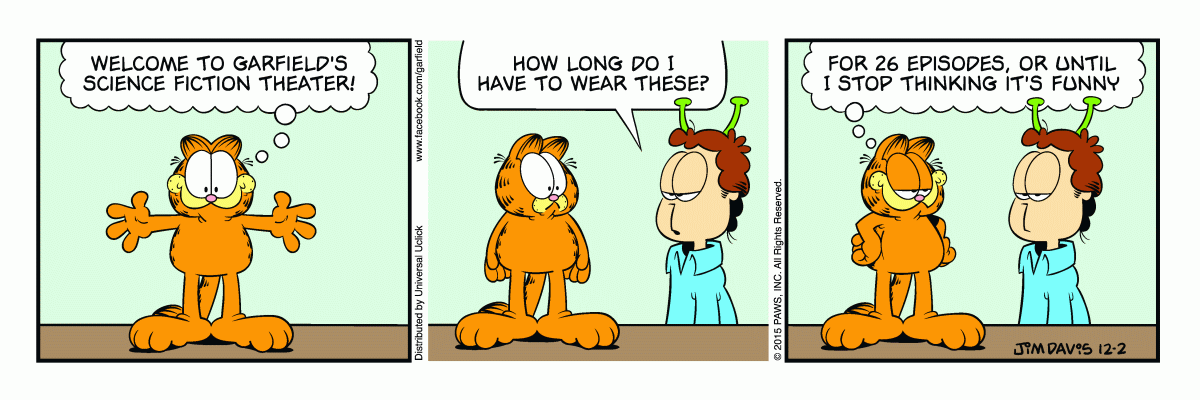Permanent Saturday: Really big at the box office

With deepest apologies to Chris Stangl, Permanent Saturday is a semiregular critical exploration of Jim Davis’ comic strips Garfield and U.S. Acres/Orson’s Farm.
Garfield and Friends was well known for its referential and self-aware style of comedy. Much of the humour from the second season onward was gleaned from poking fun at both pop culture and the capitalist industry that creates it thanks to its head writer Mark Evanier. Evanier is a veteran Hollywood jobbing scribe who was born, raised and still lives in Los Angeles, so he brings a very unique perspective to Garfield. For Evanier, celebrities and entertainers were his neighbours and fellow community members, and the business of making movies was the local industry. So when Garfield and Friends makes a joke about Hollywood agents or breaks the fourth wall and treats the Saturday Morning Cartoon Show as just another piece of primetime network television, this is not the series being especially perceptive and postmodern as much as it is Mark Evanier looking for inspiration in the people and things around him, and writing what he knows.
(Indeed, Mark Evanier’s secondary role as voice director is responsible for another thing Garfield and Friends is renowned for: Its frequent cameos from Hollywood luminaries of previous decades, mostly from stand-up comedy and the voice actor’s guild. Many of these performers had been functionally retired until Evanier had called them and asked them to guest star on Garfield.)
This puts Evanier and Garfield and Friends in staunch contrast to Jim Davis and the original strip upon which it is based. Far from being a Hollywood native who practically grew up in the business, Jim Davis was an Indiana farm boy who built Garfield and Paws, Inc. from the ground up as essentially a small business that wound up gaining international success. They are, by default, going to be operating from two wildly different positionalities and reference pools and have slightly different thematic interests (although it must be stressed that Davis and Evanier are incredibly close and have an extraordinary writing partnership: Evanier is, in fact, the only other person Davis trusts to write Garfield properly at a professional level).
So when Garfield the strip approaches looking at pop culture, it comes at it from a different angle then Garfield and Friends. The cartoon show takes the view of a deep, deep insider, cracking a *lot* of in-jokes that come squarely from Mark Evanier’s life experiences. In other words, those of an entertainment producer. The strip, by contrast, takes the view of the ordinary, everyday passive consumer of media entertainment, as we see in so many of the strips where Garfield is watching television and reacting to things he sees onscreen.
Which makes this strip, an overtly active diegetic parody of science fiction and broader genre fiction tropes, something of an oddity. Rather than snarking at a bad SF movie on TV, as he does from time to time, Garfield instead satirizes the genre himself within the basic workings of the strip itself. Another way this is different then standard Garfield operating procedure (or at least traditional Garfield) is that the cat lets the visual joke of a nonplussed Jon wearing a cheap novelty alien antennae prosthetic make the satire for him instead of verbalizing it: Visual jokes and the unspoken humour of pregnant pauses are a staple of Garfield, but usually this manifests in the title character reacting to the wacky visuals instead of instigating them. Even though in the strip’s earlier days Garfield did have a regular habit of dressing up in silly costumes and doing a pantomime routine for our amusement, this broad-strokes style of physical humour as a general rule tends to be an exception to the rule of Garfield making witty, sarcastic and acerbic comments on his surroundings. The rationale for this structure dates back to the primordial origins of the comic, where Jon was intended to be the main character and Garfield his foil.
(Indeed, even to this day, Garfield continues to find new ways to explore the true ramifications of an unattached adult man sitting alone in his house making conversation with his cat, ramifications that most readers will miss entirely.)
The specific way Garfield has chosen to poke fun at science fiction is also interesting. As is obvious to us from the first panel, Garfield’s goal is to expose science fiction’s innate theatricality: This is, as we are told, “Garfield’s Science Fiction Theater”. This is reaffirmed when the first punchline of Jon wearing deelyboppers is revealed to us in the second panel, which can be construed as a shot against the bargain-basement special effects used in old style television science fiction. Which, upon first glance, might seem to be evidence for the hackneyed line of argument that Garfield is tired and behind the times: Certainly by 2015, no science fiction worth its salt would be caught dead weathering allegations of theatricality. By then, we were all well past the point where the drive towards the cinematic had come to define discourse surrounding visual media of all kinds, but especially science fiction in the Hollywood style. With genre fiction making up the overwhelming majority of blockbuster, mega-overbudget cinematic pop culture phenomena, the days of science fiction being considered campy B-movie fare are certainly well behind us.
But this is not, in truth, the case. One reason it’s not is the second punchline, which doubles as the moment which drives home for us readers what version of Garfield we’re really in: “For 26 episodes, or until I stop thinking it’s funny”, is very much a line from within the riffing tradition. This is a joke about media literacy: Far from talking down to the audience or losing them, Garfield knows he’s in the trenches with them, and cracks an in-joke about something he expects we’re all going to have an understanding of. As seasoned, experienced consumers of media and pop culture, a title that could not exist when the strip began in 1978 (when the visual media climate hadn’t become so oversaturated such that it was expected the average person would have an intimate working knowledge of the complete runs of multiple TV shows), Garfield knows we’re all familiar with how US-style television science fiction works. The joke is about the shared experience of the visual media glut from the vantage point of a viewer, not about the quirky ways the hyperlocalized culture of Hollywood production studios operates.
Also, however, Garfield in this strip seems to display a deeper understanding of the logic of performativity and narrative storytelling. In genre fiction, themes are expressed through metaphor and allegory derived from the worldbuilding elements of the setting itself. These kind of stories really are nothing more than morality plays about our world, kept at a safe enough distance such that it’s not immediately recognisable for the viewer. This is the real reason Jon is wearing the deelybopper antennae, and why science fiction will always have such a strong theatrical heritage no matter how much money you sink into it. The point, like with all narrative, is to get at a world that has the shape of something that resembles our own. Strip all the spaceships and rockets away, and you’re left with a world that is depressingly mundane. A setting, perhaps, not unlike that of Garfield.
Can it not be said that Garfield and science fiction are trying to create the same thing? A fictional world that reminds us of our own, but is different enough so as to still function as necessary escapism? “Garfield’s Science Fiction Theater” then is a play-within-a-play, the series’ age-old postmodern trick of incessant medium awareness raising its furry head once again.
Because no matter how expensive the special effects budget or how obsessively detailed the worldbuilding detail, at the end of the day genre fiction is just another kind of story. Just one more artifice we construct to hide the realities of everyday life in our chosen mode of existence. Actors wearing green prosthetic antennae are no more or less “believable” or “realistic” than an anthropomorphic cat who eats lasagna and addresses his audience through telepathy. There is no functional difference between the Klingon homeworld, the TARDIS or Jon Arbuckle’s living room. They all serve the same purpose in the end as planes upon which we attempt to understand reality, and indeed, perhaps we’re more comfortable with the former two because we don’t want to admit we spend most of our lives in the latter.
Original Strip: December 2, 2015
Garfield: U.S. Acres/Orson’s Farm
